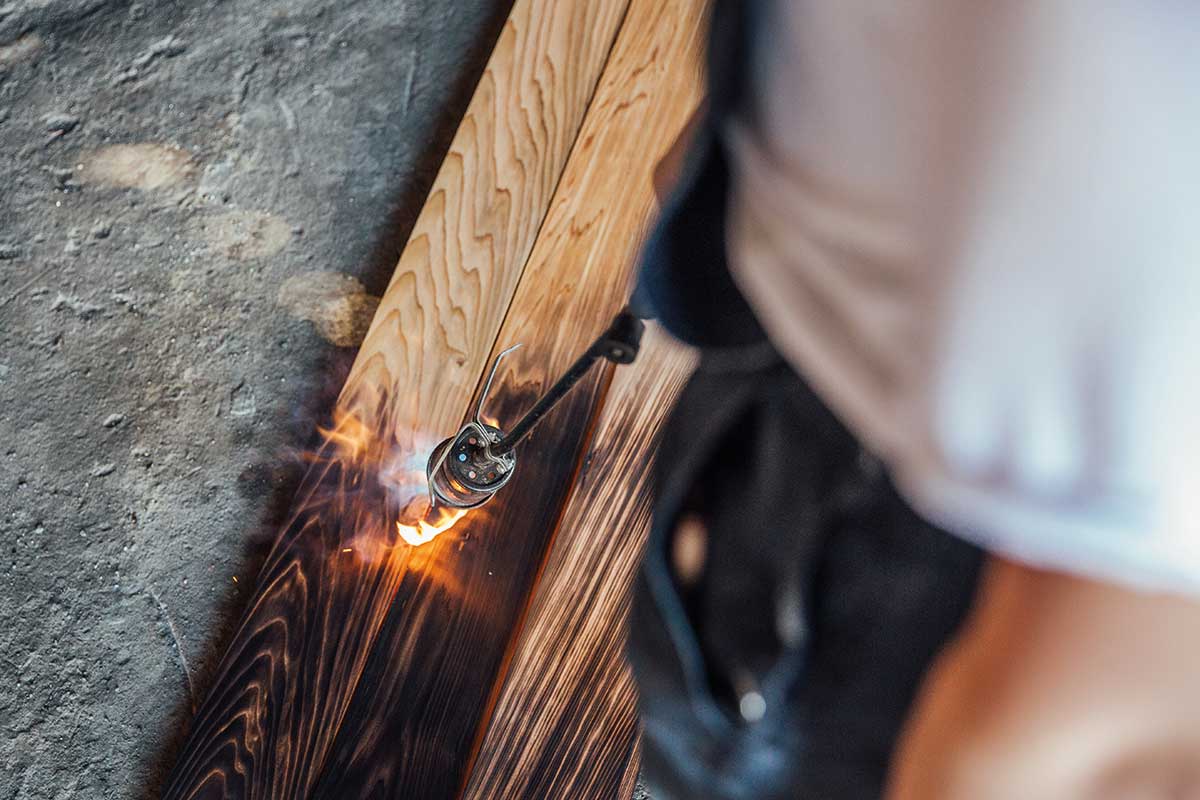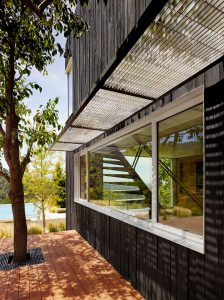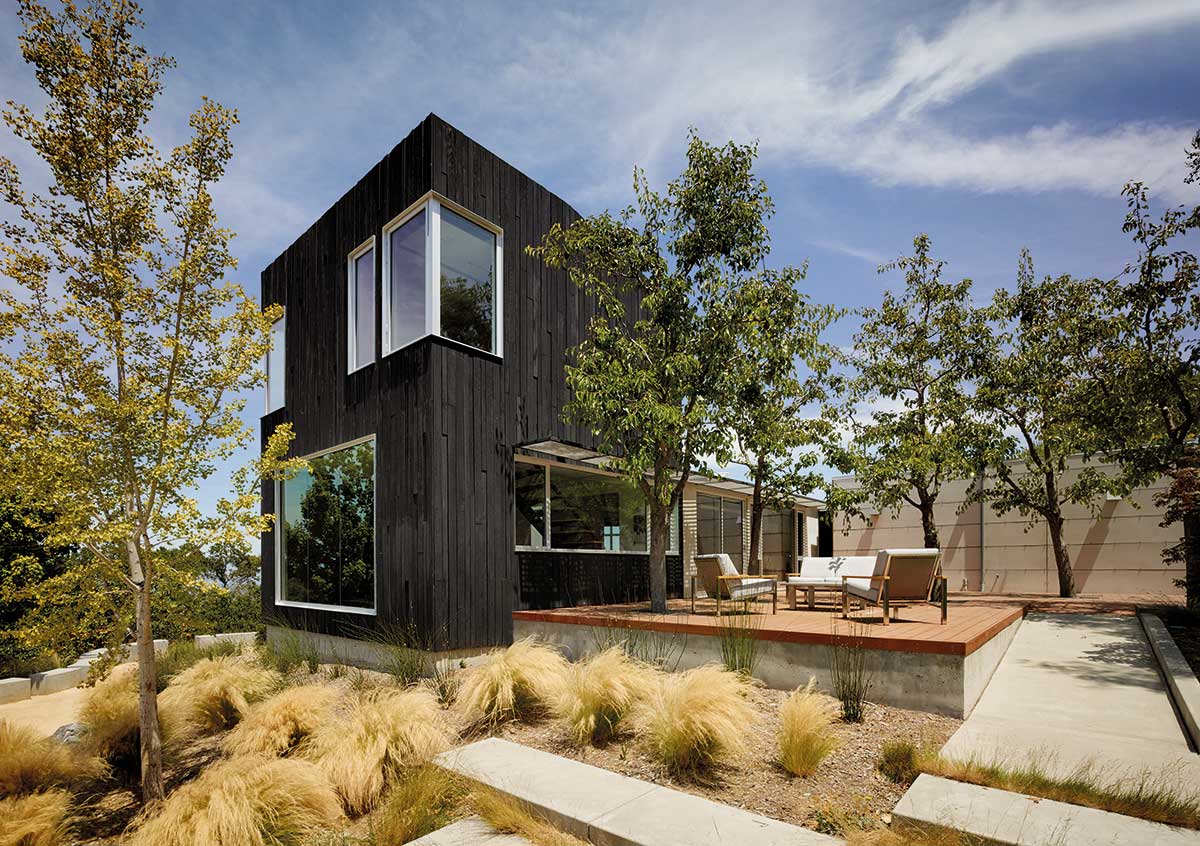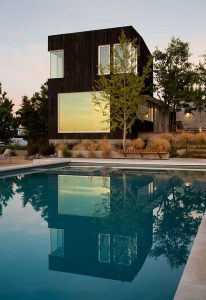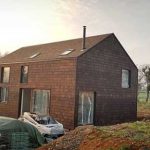Shou Sugi Ban, or charred timber, can provide a contemporary finish to your self-build both inside and out.
Also known as Yakisugi, Shou Sugi Ban is a term used to describe the ancient Japanese art of charring timber with fire. The United States, Australia, New Zealand, and many countries throughout Europe have seen a massive uptake in recent years. And it’s getting noticed in Ireland now too. Charred timber is mostly used outdoors but people are increasingly toasting up their furniture, doors, feature walls, signage, bars etc. It can make a real statement inside or out, which makes it appealing to designers and architects.
A heavier char on your exterior finish will provide a more resilient protective barrier. The oldest wooden building in the world is still standing in its Shou Sugi Ban cladding; it dates back to 711AD. There are two types; Sumi-tsuki is the traditional coarse, rough gator finish. Migaki is seen a lot in western design now and is the sleeker, smoother and more contemporary version.
Properties
Fire Proof
Have any of you experienced the dread of letting the campfire go out? Well, try relighting that blackened charred kindling fellow campers! The firing process essentially fire proofs the timber.
Water Proof
[adrotate banner="58"]Next up and something us Irish love discussing is the weather – charred wood protects against our wet Irish weather and has proven itself to be a very robust material indeed. In Northern Japan it endures extremely harsh Siberian winters, often spending long periods buried under four metres of snow. Your toasted timber is resistant to mould and spores as well, that means it won’t green up like you may see on painted or stained wood.
Insect Proof
Insects can really cause problems to your home if they decide your cladding is their equivalent to Michelin star food heaven. Luckily they can’t stand the taste of charcoal.
Virtually maintenance free
Charred timber can last long into the future with very little attention.
Process
There are a lot of stages to go through including charring at different temperatures and also finishing with a sealant. If you don’t seal the charred timber, the finish will wear off over time
and charcoal dust will blacken anything that rubs against it.
Quality control comes from paying close attention to how the wood is reacting to the flame, this ensures a consistent, top quality finish. There are plenty of DIY videos out there so while charring is certainly something you could have a go at, without having the knowledge and techniques of the pros you may get a more ‘rustic’ and perhaps amateur look.
‘It can make a real statement which appeals to designers and architects.’
Also it’s worth mentioning you shouldn’t underestimate how slow and dirty it can be. If you do have a go, please be careful with fire and gas. It is a combo not to be trifled with. As for the sealant, the Japanese traditionally use tung oil but after trying countless products and performing many high tech experiments (rock throwing included) we finally found a beautiful toxin-free, matt sealant that fully penetrates the wood protecting it from the inside out.
It also has some tint options we can add to help protect against UV fade. We apply two coats front and back to all of our toasted timber.
Wood Types
Hardwoods do burn and some people have had decent results with ash and oak, but it has been debated as to whether they allow a suitable depth of char to fully protect the wood. They’ll work fine for furniture or indoor projects but for exterior applications we tend to stick to trusty softwoods, all of which are sustainably sourced. These include:
Douglas fir
Chunky wood with plenty of knots and wide cascading grain. Rustic in appearance with some big patterns.
Siberian larch
A beautiful elegant grain, smaller and tighter in appearance, and with smaller knots than Douglas. Very versatile with lots of different burns available. (Native larch is too weak because it grows too fast.)
Western red cedar
Stunning variety in the grain. Some will ripple and ribbon through the board, whilst others are much more linear. A very light weight wood due to having lots of air capsules which makes cedar such a great insulator. Smells amazing.
Accoya
A very strong, robust wood that takes the burn phenomenally well. This is the only wood we can guarantee a beautiful full alligator finish on. It’s a very sophisticated, sleek finish.
Cost
There is no getting away from the fact that you are investing in a luxury product that has been tailor made to your exact specifications with sustainably sourced wood. If you get a professional to do it, they should bring the attention to detail and quality of craftsmanship that will land you the result you’re after. Each project is completely bespoke and some of our
finishes require up to seven different procedures for every single board.
However, in saying all of that we are confident that charred timber is much less expensive over time (starting at £80/sqm) than the labour and maintenance costs required to stain, seal, or at worst, replace other cladding solutions.
Images on this page of a project in the USA by Schwartz and Architecture for the remodel work on the addition (the original house was by Min | Day as Design Architect and Burks Toma Architects). Photography by Matthew Millman.
Words: Sasha Stewart

